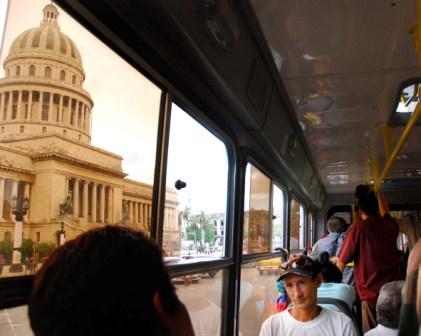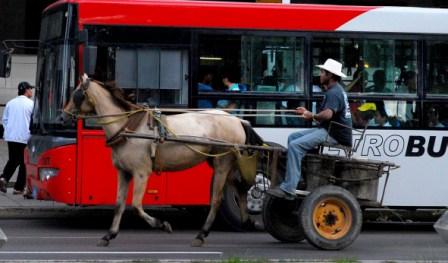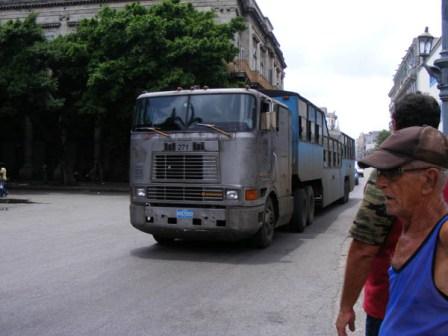Cuba Sees Major Transport Recovery
By DALIA ACOSTA

HAVANA TIMES, March 17 (IPS) – An end to Cuba’s severe transport crisis finally appears to be in sight, after three years of substantial investments and reforms, although future economic growth could pose new challenges.
“A few months ago, I used to have to leave two hours ahead of time in order to make sure I would be punctual. Now I know that I will never have to wait more than 30 minutes for a bus,” Mara Flores, who lives in a neighborhood on the outskirts of Havana, 45 minutes by car from the city centre, told IPS.
Like many people in the Cuban capital, Flores uses the government-subsidized public transport system to get to work. Last year the number of routes connecting outlying neighborhoods to the areas where economic activity is concentrated was doubled, after Chinese and Russian buses arrived on the streets.
Today there are 16 bus routes plying between the centre and the suburbs, and one which connects the outlying areas. In addition there are minor routes between these major arteries.
The optimum frequency would be one bus every 10 to 12 minutes on the routes between the outskirts and the center. The problem here is no longer the number of vehicles available, but logistics and getting buses to run on schedule.
According to the National Statistics Office (ONE), passenger transport expanded by 16.5 percent and freight carriage by 12.3 percent in 2008. The use of other means of transport, ranging from bicycles to private vehicles, grew by 2.9 percent.
In contrast, ONE statistics indicate that passenger transport fell by 58 percent over the 1990-2005 period, a cutback that hit big cities like Havana or Santiago de Cuba the worst, as well as the highway network connecting the country’s provinces.
In order to tackle the problem, the government invested millions of dollars to buy new or second-hand vehicles, especially from Russia and China. About 2,700 of these buses were already in service on the island by the end of 2008, according to official sources.
“If the annual growth rate of passenger transport remains at the level attained between 1998 and 2007 (14 percent a year), it will take five more years to reestablish the level of service existing in 1989,” said an expert source quoted in Economics Press Service, a publication of the IPS bureau in Cuba.
Driver Shortage in the Capital

But deploying an adequate transport fleet is not the only problem. The authorities have tried to improve working conditions for bus drivers and other transport workers by increasing wages and providing uniforms and training in modern technology. However, the Havana city government has had to resort to bringing in drivers from other provinces to cover the shortfall.
“The low level of training of transportation personnel is one of the main causes of the staff shortage that is limiting the effectiveness of the program,” the expert source, who recommended that the education sector should “begin to emphasize the expansion of this type of education,” was quoted as saying.
The collapse of the Cuban economy after the demise of the Soviet Union and its East European socialist allies in the early 1990s severely affected the island’s capability to move goods around the country. Railway freight alone declined from 13 million tons to five million tons at its lowest point, while one-half of all haulage trucks were decommissioned.
The transport recovery program, worth two billion dollars, got under way in 2005 and is due to end in 2010. According to declarations in the Cuban press from Transportation Minister Jorge Luis Sierra, the rehabilitation plan includes a major restructuring as well as the purchase of vehicles and equipment.
Expert sources say that in 2005 the armed forces directed a special operation known as Operación Emergente which reorganized transport of goods from the ports to their final destination, with the aim of avoiding idle freight capacity in trucks and other vehicles, reducing wear and tear and cutting down on fuel consumption.

Global positioning system (GPS) devices were introduced in trucks in an effort to discourage private use of the vehicles, a practice common in this country where making unauthorized use of state resources tends to be seen as a short cut to solving personal problems, rather than as a crime.
Cuba has devoted 500 million dollars to revitalizing the railway system. The funds were used to buy 550 freight wagons and 200 carriages from Iran and 100 engines from China, as well as purchasing materials and setting up local factories to carry out repairs on the railway lines.
The government has also earmarked some 400 million dollars to repair bridges and highways, among them the Autopista Nacional (National Freeway), which was only half-finished when the Havana-Moscow alliance broke up in the early 1990s.
Port Improvements are part of the Upturn
Another 300 million dollars are to be invested in the port terminals. During the worst years of the so-called “special period”, the euphemistic name given to the crisis – early last decade, it could take 80 days to unload a cargo ship, while the number of harbor tugs and barges supplying food and water to the ships fell drastically.
The economic crisis also devastated the national merchant fleet, which had been one of the largest in Latin America until the late 1980s. This forced the island to depend on foreign ships, which under the provisions of the U.S. Helms-Burton Act are forbidden to enter U.S. ports for six months after docking in Cuba.
The Act, named for the legislators who introduced it to Congress, Jesse Helms and Dan Burton, entered into force in 1996. It provides for retaliatory action against any non-U.S. company that trades with Cuba, tightening the embargo imposed by Washington on Havana in the 1960s.
Such restrictions create delays in the arrival of new equipment to Cuban shores. For instance, the Iranian railway stock and equipment may have to wait up to five months for embarkation until a ship can be found that is willing to take on the risks of the long crossing and of being blacklisted by Washington.
“One of the most important challenges to the transport rehabilitation program (for freight as well as for passengers) is the fact that certain kinds of demand are likely to grow in the medium term,” the Economics Press Service article predicts.
The government hopes for a six percent growth rate in GDP this year, compared to 4.3 percent in 2008.
Transportation services, while still recovering from their huge setback, must cope with the expected economic surge, “particularly the higher agricultural, livestock and industrial production,” the expert source said.





